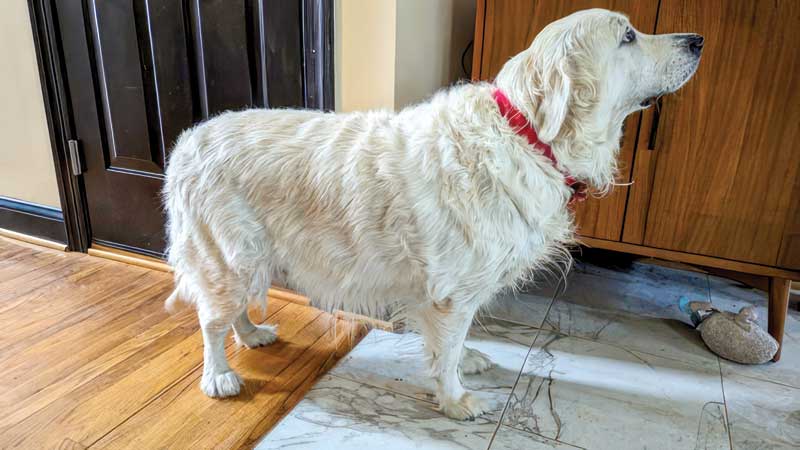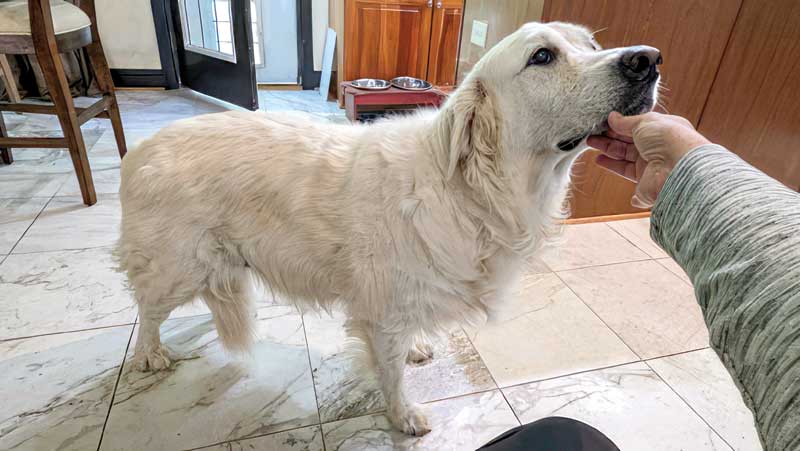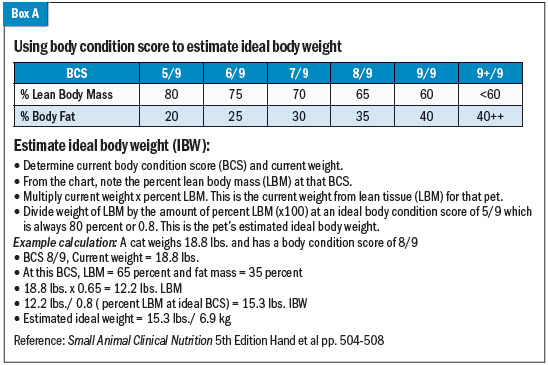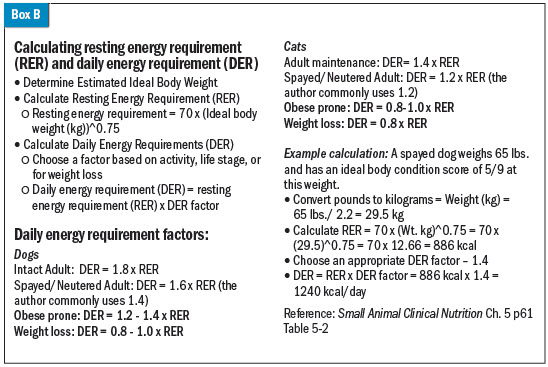
The incidence of overweight and obesity in pets has increased significantly, affecting up to 59 percent of dogs and 61 percent of cats.1 Unfortunately, pet owners often fail to recognize this problem with nearly one-third (32 percent) of owners of overweight pets describing their dog or cat as “normal,” “ideal,” or even “thin,” when asked by their veterinarians.1 Sadly, this means the majority of pets entering the veterinary hospital are already on course to develop a disease condition (obesity) and cannot be considered completely healthy.
Overweight and obesity are associated with multiple disease conditions, including joint/mobility disorders, endocrine (diabetes), cardiorespiratory, urinary diseases, and even cancers.2-4 Ultimately, this translates into greater financial and emotional burdens for pet owners, decreased quality of life and a decreased life span for pets.4-6 It is imperative veterinarians proactively assess each patient for risk of overweight/obesity often and early, as well as have strategies in place to help pet owners prevent and manage this disease condition.
Prevention as a strategy
Success rates for weight loss programs are poor. Two multi-country survey studies of veterinarians in general practice noted only around seven percent of dogs were able to achieve ideal body weights as part of a weight loss program, with up to 37 percent dropping out. Similarly, only five percent of cats were able to achieve targeted ideal weights.7,8
Factors identified that are key to successful outcomes with veterinary guided weight loss include owner compliance along with frequency of veterinary communication and follow-up.9,10 As weight loss can be difficult, it is important for veterinarians to be proactive in educating clients on the potential risks of overweight and obesity, body condition scoring, and preventative strategies that will control nutrition and body weight.
Starting with puppy/kitten examination and vaccine visits, a diet history should be taken, and veterinary staff can help start the conversation on body condition scoring directly to owners.
Client education on reading pet food and treat labels, calorie control and avoiding excessive treats should be provided. Weight checks and body condition scoring can continue during these early visits every few months, alongside refilling heartworm/flea/tick prevention or any vaccine boosters with six-month intervals.
Discussion on selection of appropriate diets, calorie control, and avoiding overfeeding should be emphasized. Veterinarians may be reluctant to discuss particular pet food brands, but pet owners should be assisted in choosing appropriate diets and choosing correct feeding amounts to help maintain an ideal body condition score.
Survey data confirms clients truly want the veterinarian’s recommendation for a pet food, with specific diet recommendation (brand, exact amount). This is key to the client’s follow through in feeding that diet.11,12
Additionally, during these early years, owners should be made aware that the spay/neuter procedure will lower metabolism and increase risk of weight gain. Reduction of calorie intake and a change in diet must be considered to prevent the inevitable weight gain that will occur for most pets if no adjustments are made in the feeding plan.

Catching it early
Given most pets are spayed and neutered in veterinary practices early in life (90 percent of dogs and cats), weight gain may commonly occur following this event, even starting within a few days post-procedure.14-16
Catching weight gain earlier (at body condition scores of 5-6/9) will allow pet owners and veterinarians to make adjustments before obesity is established and help avoid the secondary impacts of this disease state.
A diet history may reveal inappropriate feeding amounts or diet type for that individual pet (foods with high caloric density or very high fat content). Often, a diet change is needed and diets can be chosen for obese prone pets that may help better manage metabolic and appetite challenges. Research confirms that higher protein, higher fiber and lower fat diets can help better prevent weight gain for spayed and neutered pets.16,17
What about those treats?
A quick glance at any grocery store pet section or specialty pet stores will quickly show an abundance of available treats for pets. Treating is one way owners wish to show love to their pets and it should be accounted for. This is one area, however, where pet owners may lose control of calorie intakes. A treat inventory should be done to account for calories contributed to the total calorie intake per day.
Treats can be incorporated in the feeding plan, as most pet owners will demand this. By convention, veterinary nutritionists recommend no more than 10 percent of the diet (or 10 percent of calories) should be from treats or snacks fed beyond the complete and balanced diet.11
For puppies during training, using a complete and balanced puppy kibble as a treat can be a strategy to maintain a balanced diet and avoid excessive calorie intake from treats. Checking all treats for calorie content is essential to have awareness of calories coming in from these extra foods.
Calorie content of treats may be as low as 2-5 kcal/treat or as high as 50 kcal+ each. If no nutrition data is available, the treat should be an occasional indulgence or avoided entirely. Dental chews and dental treats also need to be scrutinized for calorie content as these can be quite high in calories. Pet supplements and “pill dough” or other vehicles used for medication administration can also be a source of overlooked calories (fish oils, chews, etc.) and calories from these items should be counted within the treat allowance.
What to do when it’s too late
Once the pet is diagnosed overweight, owner education is essential to make changes for that family and pet to help move them towards a more ideal body weight. If not done previously, the diet history should be reviewed and an accounting of all foods and treats should be done to help determine the pet’s actual current caloric intake.
Veterinary staff (technicians, assistants) can take the lead on the pet’s weight management plan with oversight from the veterinarian. The pet’s current body condition score can be used to help estimate the ideal body weight (Box A).

Body condition scoring can be subjective but can be very helpful in guiding decision-making on calorie amounts for the nutrition plan. Using an estimated ideal body weight can then be used to calculate a “resting energy requirement” (RER) and then a factor for weight loss is applied to determine the daily energy requirement (DER) (Box B). Owner education should be emphasized that the calculated energy requirements and feeding amounts are only a starting place and adjustments are commonly required at regular intervals during the weight loss journey for each pet. In some cases, simply choosing a feeding amount (calorie amount) that is 20 percent less than the prior fed will help begin successful weight loss.

Choosing the diet
Once ideal body weight and the estimated feeding amount for weight loss is determined, choosing an appropriate diet that will support weight loss is the next important step. Diets higher in protein and fiber and lower in fat and calorie density are most appropriate for weight loss for most dogs as they will support satiety and fat loss while sparing lean tissue. For cats, choosing a high protein, moderate fat, lower carbohydrate and portion controlled wet diet may be considered.
Frequent follow-ups with veterinary staff biweekly or monthly should be scheduled either in person or virtually to check in and help keep clients motivated and on track. Each pet and pet owner are unique in their needs and designing the best support plan will vary. What level of calorie restriction a pet requires to successfully achieve weight loss will also vary. A safe rate of weight loss is around 0.5-2.0 percent of current body weight per week and slower rates are often targeted for pets with concurrent disease states.
If a patient is not achieving weight loss, the feeding amount can be further reduced (consider lowering calories 10-15 percent more) as long as this is appropriate for the food being fed. It is not recommended to feed commercial diets well below product feeding guidelines for the pet’s ideal body weight. If a commercial diet must be greatly restricted, a therapeutic weight loss diet should be chosen and/or consultation with the product manufacturer or preferably a veterinary nutritionist can be requested to help design a custom weight loss plan for that patient.
Comorbidities can make it challenging
Disease conditions may create challenges for weight management, either by increasing the risk of overweight/obesity, limiting diet selection, or creating nutritional needs that are in conflict with preferred nutrient levels for managing weight. For example, a dog with chronic renal disease may need a diet that is lower in protein; however, restricting a therapeutic renal diet to reduce weight may cause protein and amino acid intakes to fall short of optimal levels for satiety and maintenance of lean body mass or it could potentially create a risk of deficiency of essential amino acids.
It is important to identify key nutrients of concern for each of the pet’s disease conditions, what the target levels of nutrients should be and which nutrients may be in conflict with weight management. For exceptionally difficult cases with multiple comorbidities, seeking input from veterinary nutritionists on staff with manufacturers of therapeutic diets or a consultation with veterinary nutritionist is ideal and can be invaluable.
The most difficult weight loss cases
In some cases, dogs or cats may truly require significant caloric restriction to avoid weight gain or achieve weight loss. The level of restriction needed may be below what is recommended by product guide feeding suggestions, even for the therapeutic weight loss diets. The amount fed is even well below the pet’s calculated resting energy requirement (RER) at ideal body weight. In these cases, examining the exact daily intakes of essential nutrients (amino acids, fatty acids, vitamins, and minerals) is ideal, to avoid multiple nutrient deficiencies. It is not appropriate to greatly restrict average commercial diets or even diets sold as weight management diets “over the counter.” Previous studies have documented multiple nutrients are at risk of deficiency for both dogs and cats when this approach is used, including choline, methionine, cysteine, arginine, phenylalanine, tyrosine, threonine, selenium, omega 3 fatty acids, B vitamins.18-20
A custom diet can be formulated by a veterinary nutritionist for an individual pet’s needs. The author has used carefully balanced homemade diets formulated for the individual to be high protein, high fiber, low fat and low in caloric density so a balanced diet with a high volume of food can be fed with the lowest calorie density to help provide both satiety and best nutrition during weight loss. Custom diet preparation is now available through a select few fresh food companies.
Making recommendations
As veterinarians, our goal is to support the best health for our patients and providing guidance on nutrition builds the foundation for good health. We are experiencing an epidemic in overweight and obesity in our pets. As maintenance of a lean body weight is highly associated with longevity, providing guidance for weight management should be an essential discussion throughout the pet’s life.
Preventive nutrition can start with the puppy/kitten visits, be reviewed at the time of spay/neuter, and then continue to be closely monitored throughout the pet’s life. When disease conditions occur, changes in diet may be needed but careful thought must be put into choosing diets that balance key nutrients of concern alongside needs for best weight management. For complex cases, seeking input from a veterinary nutritionist can be invaluable to providing best nutrition care for our veterinary patients.
Laura B. Gaylord, DVM, DACVIM (Nutrition), is an independent consultant and the owner/founder of Whole Pet Provisions, PLLC, a nutrition consulting company established in 2016, which offers veterinary nutrition consulting to pet owners, veterinarians, the pet food industry, and pet supplement companies. Dr. Gaylord offers homemade diet recipe formulation and commercial diet consultations through her business for pet parents and their veterinary team.
References
- 2022 Pet Obesity Prevalence Survey – https://www.petobesityprevention.org/2022; last accessed 10/16/23.
- Shepherd M. Canine and Feline Obesity Management. Vet Clin North Am Small Anim Pract 2021;51:653-667.
- German AJ, Woods GRT, Holden SL, et al. Dangerous trends in pet obesity. Vet Rec 2018;182:25.
- Salt C, Morris PJ, Wilson D, et al. Association between life span and body condition in neutered client-owned dogs. J Vet Intern Med 2019;33:89-99.
- Yam PS, Butowski CF, Chitty JL, et al. Impact of canine overweight and obesity on health-related quality of life. Prev Vet Med 2016;127:64-69.
- Bomberg E, Birch L, Endenburg N, et al. The Financial Costs, Behaviour and Psychology of Obesity: A One Health Analysis. J Comp Pathol 2017;156:310-325.
- Flanagan J, Bissot T, Hours MA, et al. Success of a weight loss plan for overweight dogs: The results of an international weight loss study. PLoS One 2017;12:e0184199.
- Flanagan J, Bissot T, Hours MA, et al. An international multi-centre cohort study of weight loss in overweight cats: Differences in outcome in different geographical locations. PLoS One 2018;13:e0200414.
- Saker KE, Remillard RL. Performance of a canine weight-loss program in clinical practice. Vet Ther 2005;6:291-302.
- Porsani MYH, Teixeira FA, Amaral AR, et al. Factors associated with failure of dog’s weight loss programmes. Vet Med Sci 2020;6:299-305.
- Cline MG, Burns KM, Coe JB, et al. 2021 AAHA Nutrition and Weight Management Guidelines for Dogs and Cats. J Am Anim Hosp Assoc 2021;57:153-178.
- Association WSAV. Nutritional Assessment Guidelines. 2011; https://wsava.org/wp-content/uploads/2020/01/WSAVA-Nutrition-Assessment-Guidelines-2011-JSAP.pdf.
- Kanchuk ML, Backus RC, Calvert CC, et al. Weight gain in gonadectomized normal and lipoprotein lipase-deficient male domestic cats results from increased food intake and not decreased energy expenditure. J Nutr 2003;133:1866-1874.
- Kanchuk ML, Backus RC, Calvert CC, et al. Neutering induces changes in food intake, body weight, plasma insulin and leptin concentrations in normal and lipoprotein lipase-deficient male cats. J Nutr 2002;132:1730s-1732s.
- Linder D, Mueller M. Pet obesity management: beyond nutrition. Vet Clin North Am Small Anim Pract 2014;44:789-806, vii.
- Weber M, Bissot T, Servet E, et al. A high-protein, high-fiber diet designed for weight loss improves satiety in dogs. J Vet Intern Med 2007;21:1203-1208.
- Keller E, Sagols E, Flanagan J, et al. Use of reduced-energy content maintenance diets for modest weight reduction in overweight cats and dogs. Res Vet Sci 2020;131:194-205.
- Linder DE, Freeman LM, Morris P, et al. Theoretical evaluation of risk for nutritional deficiency with caloric restriction in dogs. Vet Q 2012;32:123-129.
- Gaylord L, Remillard R, Saker K. Risk of nutritional deficiencies for dogs on a weight loss plan. J Small Anim Pract 2018;59:695-703.
- Grant CE, Shoveller AK, Blois S, et al. Dietary intake of amino acids and vitamins compared to NRC requirements in obese cats undergoing energy restriction for weight loss. BMC Vet Res 2020;16:426.
